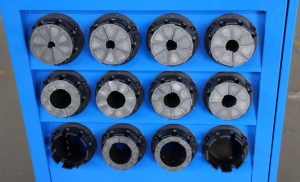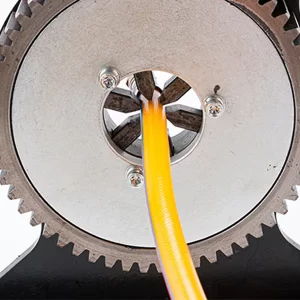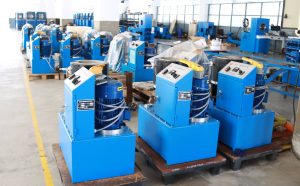When it comes to hydraulic hose crimping, environmental factors play a huge role in the success or failure of a crimp. Hydraulic hoses are essential components in many industrial systems, and ensuring they perform optimally requires careful attention to the conditions in which they are used. In this article, we will dive into the various environmental factors that can affect hydraulic hose crimping performance, explaining how temperature, humidity, pressure fluctuations, and more can influence the overall integrity of the crimped connection.
1. What Environmental Factors Affect Hydraulic Hose Crimping Performance?
Hydraulic hose crimping is a precision task that involves the careful application of force to secure a fitting onto a hose. But here’s the kicker—if environmental factors aren’t considered, even the best crimping machine can fail to produce reliable results. Factors such as temperature extremes, humidity, UV exposure, vibration, and dust can all affect the crimping process.
These environmental elements can impact the materials used in the hoses and fittings, alter the effectiveness of the crimping tool, and reduce the quality of the final connection. Understanding the interplay between these factors and crimping quality is crucial for anyone working with hydraulic systems, as failure to account for these variables can lead to costly repairs and downtime.
In this article, we will explore each of these environmental factors in detail, providing insights into how they impact hydraulic hose crimping performance. We will also discuss best practices and preventive measures to help operators ensure that their crimping processes remain accurate, efficient, and safe.
Table: Environmental Factors and Their Impact on Hydraulic Hose Crimping
| Environmental Factor | Impact on Crimping | Potential Risks |
|---|---|---|
| Temperature Extremes | Can weaken or stiffen hose materials | Hose failure, weak connections |
| Humidity | Increases corrosion and moisture buildup | Rust, degraded materials |
| UV Exposure | Degrades hose materials over time | Reduced hose durability, leaks |
| Dust and Contamination | Affects fitting connections and tool function | Poor crimping quality, contamination |
| Vibration | Causes wear on fittings and hose connections | Hose slippage, connection failure |
2. How Do Temperature Extremes Impact Hydraulic Hose Crimping?
Temperature is one of the most significant environmental factors that affect hydraulic hose crimping. Both high and low temperatures can have a profound impact on the performance and integrity of crimped connections. But what’s the real story? If the temperature isn’t properly managed during the crimping process, it can result in weak crimps, hose material degradation, and premature failures.
At high temperatures, the hose material becomes more flexible, which can cause the fitting to shift or loosen over time. In contrast, low temperatures make the hose stiffer, which can make it harder to apply an accurate crimp, potentially resulting in a less secure connection. In both cases, the lack of precision in crimping due to temperature extremes can lead to leaks or hose failures.
Additionally, temperature fluctuations can affect hydraulic fluid viscosity, which can impact the crimping pressure needed for an effective seal. Crimping at the wrong pressure, either too high or too low, can compromise the fitting’s integrity and lead to poor performance under pressure.
Table: Effects of Temperature on Hydraulic Hose Crimping
| Temperature Range | Effect on Hose Material | Impact on Crimping |
|---|---|---|
| High Temperature (above 100°F) | Hose becomes more flexible | Loose connection, potential leaks |
| Low Temperature (below 32°F) | Hose becomes stiffer and brittle | Difficult crimping, weak connection |
| Rapid Fluctuations | Causes expansion and contraction | Increased risk of hose damage |
3. How Does Humidity Affect Hydraulic Hose Crimping Performance?
Humidity, or the amount of moisture in the air, can have a significant impact on hydraulic hose crimping. High humidity levels can cause corrosion of both the hose fittings and crimping tools, which compromises the quality of the crimp. The presence of moisture can also lead to the degradation of the hose material, particularly rubber hoses, causing them to become brittle over time.
Furthermore, moisture can create a build-up of condensation inside the hose, which may lead to internal rust or chemical reactions within the hydraulic fluid. These conditions can cause the hose to fail prematurely or result in leaks, affecting the performance of the entire hydraulic system.
But here’s the kicker—by implementing effective moisture control measures, such as using corrosion-resistant fittings, operators can reduce the risk of humidity-related issues and ensure that their crimped connections remain secure and long-lasting.
Table: Impact of Humidity on Hydraulic Hose Crimping
| Humidity Level | Effect on Hose and Fittings | Potential Risks |
|---|---|---|
| High Humidity | Increased corrosion and material degradation | Hose failure, rust, leaks |
| Low Humidity | Less impact, but still possible wear | Minor material degradation over time |
| Extreme Moisture | Condensation build-up inside hose | Rust, degradation of hydraulic fluid |
4. What Impact Does UV Exposure Have on Hydraulic Hoses and Fittings?
UV exposure can be a silent destroyer of hydraulic hoses, especially in outdoor environments. The UV rays from the sun break down the molecular structure of the hose material, causing it to weaken and crack over time. This is where it gets interesting—when hoses become brittle from UV degradation, they are more likely to develop leaks or fail under pressure.
UV exposure can also affect the fitting and crimp area, weakening the connection between the hose and the fitting. This can create a weak spot in the hydraulic system that may fail when under stress, causing fluid leakage or system downtime.
To mitigate the effects of UV exposure, it is essential to use hoses with UV-resistant coatings or covers. These coatings act as a protective barrier, ensuring that the hose remains strong and reliable even when exposed to sunlight for prolonged periods.
Table: UV Exposure and Its Effects on Hydraulic Hose Crimping
| Exposure Type | Effect on Hose Material | Impact on Crimping and System Performance |
|---|---|---|
| Prolonged UV Exposure | Degradation and brittleness of hose | Hose cracking, leaks, and system failure |
| UV-Resistant Coatings | Protects hose material from UV damage | Increased hose durability and reliability |
5. How Does Dust and Debris Affect Hydraulic Hose Crimping?
Dust and debris may seem like minor nuisances, but they can have a major impact on hydraulic hose crimping performance. When dirt and particles enter the crimping area, they can contaminate the hose and fittings, preventing a proper seal. Contaminants can also cause the crimper to malfunction or create inconsistent crimps, which reduces the overall effectiveness of the crimped connection.
In addition, dust can lead to wear and tear on crimping tools, affecting their ability to create precise crimps. A buildup of dust on the crimper can also interfere with the alignment of the hose and fitting, resulting in poorly crimped connections.
To protect against dust and debris, it’s essential to use proper storage methods and maintain a clean working environment. Using covers or seals on crimping equipment can also help reduce the amount of dust exposure during the crimping process.
Table: Effects of Dust and Debris on Hydraulic Hose Crimping
| Contaminant Level | Impact on Hose and Fitting Connections | Potential Issues |
|---|---|---|
| High Dust/Contamination | Prevents proper sealing, causes misalignment | Poor crimps, reduced fitting integrity |
| Low Dust/Contamination | Minimal impact, though still a factor | Slight crimp imperfections over time |
6. What Role Does Vibration Play in Hydraulic Hose Crimping?
Vibration is an often-overlooked factor in hydraulic hose crimping, but it can cause significant issues in high-vibration environments. Vibration can gradually loosen crimped fittings, leading to hose slippage or leakage. This is where it gets interesting—vibration can also cause internal damage to the hose, leading to structural failures that aren’t immediately visible.
In machinery and industrial settings, hydraulic hoses are often subjected to continuous vibrations. Over time, this constant movement can weaken the crimp, especially if the crimping process wasn’t performed with precise pressure and alignment. As a result, hydraulic systems in high-vibration environments may experience more frequent failures unless special precautions are taken.
To mitigate the effects of vibration, it’s crucial to use anti-vibration fittings and secure hoses with additional support, such as clamps or vibration dampeners. These measures help ensure that the hoses remain securely in place and maintain the integrity of the crimped connection.
Table: Impact of Vibration on Hydraulic Hose Crimping
| Vibration Level | Effect on Hose and Fittings | Potential Issues |
|---|---|---|
| High Vibration | Causes fitting loosening and hose wear | Hose slippage, leaks, and system failure |
| Low Vibration | Minimal impact | Increased wear over time |
| Anti-Vibration Measures | Secures hose and fittings in place | Reduced likelihood of vibration-related failure |
7. How Can You Improve Hydraulic Hose Crimping Performance in Harsh Environments?
Improving hydraulic hose crimping performance in challenging environments starts with selecting the right materials and tools. But here’s the kicker—using high-quality materials that are resistant to environmental factors can prevent premature failures and reduce downtime. High-pressure hydraulic hoses that are UV-resistant, abrasion-resistant, and able to withstand temperature extremes are a good start.
Additionally, ensuring that crimping tools are maintained and calibrated regularly will improve the accuracy and quality of each crimp. Proper storage of hoses, regular cleaning of tools, and using the correct crimping pressure are all essential practices for maintaining consistent performance in harsh environments.
By investing in the right tools, training, and maintenance, businesses can reduce the impact of environmental factors on their crimping processes, ensuring better system reliability and longevity.
Table: Best Practices for Crimping in Harsh Environments
| Best Practice | Description | Benefit |
|---|---|---|
| Using High-Quality Hoses | Select hoses that resist UV, abrasion, and temperature extremes | Increased durability and reliability |
| Regular Maintenance | Clean and calibrate crimping tools regularly | Ensures accurate crimps and reduces tool wear |
| Proper Storage | Store hoses in controlled environments | Protects hoses from environmental damage |
Conclusion
In conclusion, environmental factors play a pivotal role in the performance and reliability of hydraulic hose crimping. Temperature, humidity, UV exposure, dust, and vibration all have the potential to impact the crimping process, leading to weak connections, leaks, and system failures. By understanding the effects of these environmental challenges and taking preventive measures, operators can significantly improve the longevity and efficiency of their hydraulic systems.
FAQ Section
Q1: What is hydraulic hose crimping?
Hydraulic hose crimping is the process of attaching hydraulic fittings to hoses using a crimping tool. This ensures a secure and leak-proof connection that can withstand high pressures.
Q2: How does temperature affect hydraulic hose crimping?
Extreme temperatures can cause hoses to become too flexible or too stiff, making it difficult to achieve a proper crimp. This can lead to weak connections and hose failure.
Q3: What role does humidity play in hydraulic hose crimping?
High humidity can cause corrosion on the fittings and hoses, leading to weakened connections and premature failure. Moisture build-up can also degrade the hose material over time.
Q4: How does vibration impact hydraulic hose crimping?
Vibration can cause crimped fittings to loosen over time, potentially leading to leaks or hose slippage. It can also lead to internal hose damage, weakening the system’s integrity.
Q5: How can you improve hydraulic hose crimping performance in harsh environments?
Using high-quality, durable hoses, maintaining crimping tools, and storing hoses properly can help mitigate the impact of environmental factors and ensure better crimping performance.




